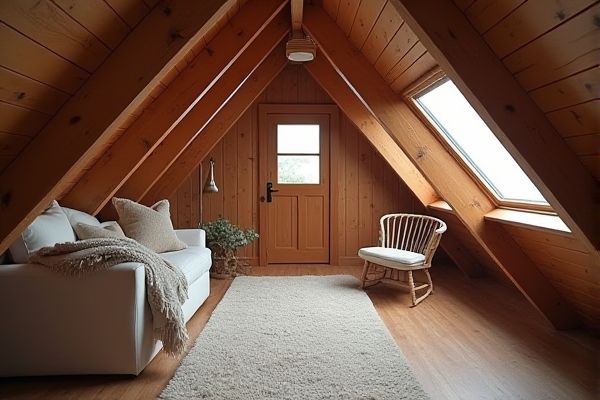
Choosing between a scuttle attic and a walk-in attic depends on your storage needs and accessibility preferences, as scuttle attics offer limited space accessed by a small hatch, while walk-in attics provide ample room and easier movement. Explore the rest of the article to determine which attic type best suits your home's functionality and your storage requirements.
Table of Comparison
| Feature | Scuttle Attic | Walk-In Attic |
|---|---|---|
| Access | Small opening, often a hatch or panel | Full-size door with stairs or ladder |
| Space | Limited, crawl space only | Large, can be used as storage or living area |
| Usage | Insulation, wiring, occasional storage | Extensive storage, finished rooms, HVAC equipment |
| Ease of Access | Requires crawling, less convenient | Easy entry, walkable floor |
| Cost | Lower construction and maintenance cost | Higher cost due to size and features |
| Safety | Limited safety, risk in climbing through small opening | Safer with proper flooring and lighting |
Scuttle Attic vs Walk-In Attic: Key Differences
A scuttle attic features a small access panel, typically in a ceiling, allowing entry for maintenance but limited headroom and usability, while a walk-in attic offers a full-sized entrance with ample space for storage or living purposes. Walk-in attics often have finished flooring, insulation, and lighting, enhancing functionality compared to the unfinished, cramped nature of scuttle attics. The key differences lie in accessibility, size, and potential uses, with walk-in attics providing greater versatility and comfort.
What Is a Scuttle Attic?
A scuttle attic is a small, crawl space accessed through a removable panel or hatch, typically found in ceilings and designed for occasional storage or maintenance access. Unlike a walk-in attic, which offers ample room for movement and extensive storage, a scuttle attic provides limited space and headroom, restricting its usability. Its compact design makes it ideal for housing insulation, HVAC components, or electrical wiring rather than serving as a functional living or storage area.
What Is a Walk-In Attic?
A walk-in attic is a spacious attic space designed for easy access and movement, often featuring sufficient height and floor area to allow standing and storage comfortably. Unlike a scuttle attic, which is accessed through a small hatch and provides limited headroom and usability, walk-in attics can serve as functional storage rooms or even converted living spaces. Their larger, accessible design makes them ideal for homeowners needing substantial storage without compromising accessibility.
Benefits of a Scuttle Attic
A scuttle attic offers easier and more cost-effective access compared to a walk-in attic, making it ideal for homeowners seeking quick storage solutions without extensive renovations. Its compact design minimizes heat loss and enhances energy efficiency, preserving your home's insulation. You save valuable space and reduce maintenance costs with a scuttle attic, providing practical benefits while maintaining structural simplicity.
Benefits of a Walk-In Attic
A walk-in attic offers substantial storage space, making it ideal for organizing seasonal items, boxes, and larger belongings with ease. Its accessibility enhances safety and convenience during inspections, maintenance, or repairs compared to the limited entry of a scuttle attic. Improved ventilation and potential for insulation upgrades in walk-in attics contribute to better energy efficiency and overall home comfort.
Storage Potential: Scuttle Attic vs Walk-In
Scuttle attics offer limited storage potential due to restricted access and low ceiling height, making them suitable only for lightweight, infrequently used items. Walk-in attics provide significantly greater storage capacity with easier accessibility and the ability to organize belongings more efficiently. Homeowners seeking functional storage spaces benefit from walk-in attics, which accommodate heavier and bulkier items compared to scuttle attics.
Accessibility and Usability Comparison
Scuttle attics offer limited accessibility through a small hatch, making them suitable for occasional storage but restricting movement and usability. Walk-in attics provide spacious access with full entry doors and ample headroom, enhancing usability for regular storage, maintenance, or even conversion into living spaces. Your choice depends on how frequently you'll access the attic and the level of functionality you require.
Insulation and Energy Efficiency Considerations
Scuttle attic access often presents challenges for insulation due to its limited entry point, increasing the risk of air leaks and heat loss without proper sealing and weatherstripping. Walk-in attics allow for more comprehensive insulation coverage on the roof and floor joists, enhancing energy efficiency by maintaining consistent temperature control. To optimize your home's energy performance, focus on air sealing and high-quality insulation regardless of attic type, but walk-in attics generally offer easier access for regular maintenance and upgrades.
Cost Implications: Installation and Maintenance
Scuttle attics generally incur lower installation costs due to their smaller access panels and minimal structural alterations, making them a budget-friendly option. Walk-in attics require more extensive framing, flooring, and insulation, which raise both initial installation and ongoing maintenance expenses. Regular maintenance costs for walk-in attics include HVAC system upkeep and potential moisture control, whereas scuttle attics typically demand less frequent intervention due to limited accessibility.
Choosing the Right Attic Type for Your Home
Choosing between a scuttle attic and a walk-in attic depends on your storage needs and available space. Scuttle attics provide limited access through a small hatch, ideal for occasional storage or maintenance, while walk-in attics offer ample room for organized storage or converting into functional living space. Your decision should consider ceiling height, insulation requirements, and how frequently you plan to access the attic.
 homyna.com
homyna.com